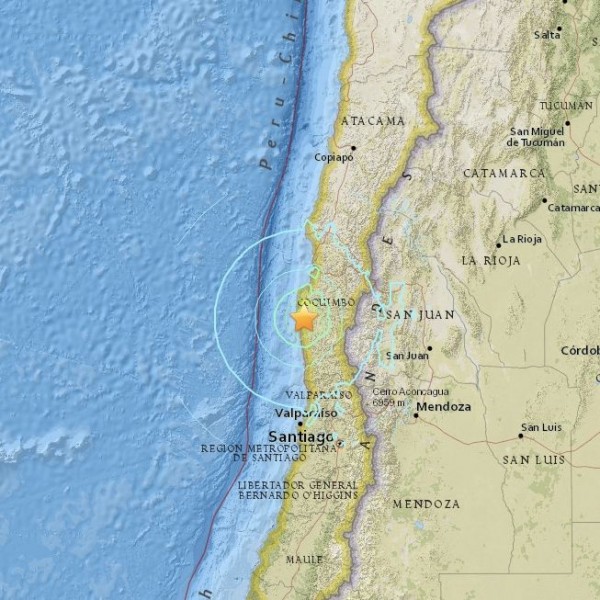
A strong earthquake of 6.8-magnitude rocked Chile’s central coast early Saturday, according to the U.S. Geological Survey. It struck 66 miles (107 km) from Coquimbo, Chile at 0731 UTC on November 7, 2015 (2:31 a.m. EST). This quake took place in the same approximate region as a much more powerful quake, two months ago.
No tsunami warning was issued.
There were no immediate reports of damage or injuries.
Today’s quake followed a larger one two months ago that struck off Chile’s coast, triggering a 16-foot tsunami wave in one place, plus other large waves, that washed over coastal towns in Chile. The September 17, 2015 quake was 8.3 magnitude, and it ultimately caused 11 deaths in Chile and over 1 million to evacuate. Following the September quake, tsunami advisories were issued as far away as California and Hawaii.
Details of today’s quake from USGS follow:
Region: COQUIMBO, CHILE
Geographic coordinates: 30.906S, 71.544W
Magnitude: 6.8
Depth: 36 km
Universal Time (UTC): 7 Nov 2015 07:31:42
Time near the Epicenter: 7 Nov 2015 04:31:43
Location with respect to nearby cities:
47 km (29 mi) SW of Ovalle, Chile
61 km (37 mi) WSW of Monte Patria, Chile
88 km (54 mi) NNW of Illapel, Chile
107 km (66 mi) S of Coquimbo, Chile
295 km (182 mi) NNW of Santiago, Chile
Chile has frequent earthquakes. Today’s quake – like the stronger one in September – was caused by the movement of great land plates along Chile’s coastline. USGS said that this area:
… marks the plate boundary between the subducting Nazca plate and the South America plate, where the oceanic crust and lithosphere of the Nazca plate begin their descent into the mantle beneath South America. The convergence associated with this subduction process is responsible for the uplift of the Andes Mountains, and for the active volcanic chain present along much of this deformation front. Relative to a fixed South America plate, the Nazca plate moves slightly north of eastwards at a rate varying from approximately 80 mm/yr in the south to approximately 65 mm/yr in the north. Although the rate of subduction varies little along the entire arc, there are complex changes in the geologic processes along the subduction zone that dramatically influence volcanic activity, crustal deformation, earthquake generation and occurrence all along the western edge of South America.
Bottom line: Strong earthquake along coast of central Chile. Same approximate region as much more powerful quake, two months ago. No tsunami warning. No immediate reports of damage or injuries.











